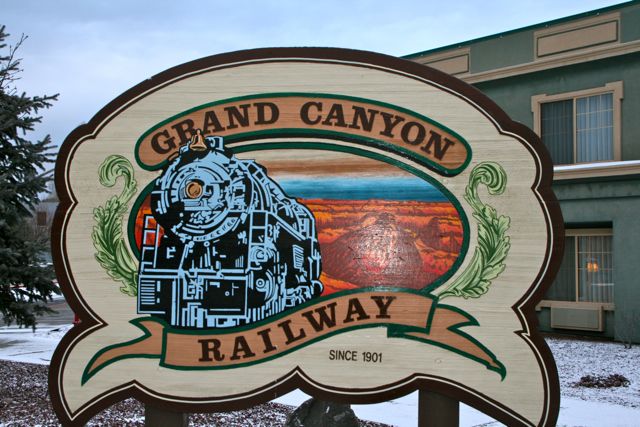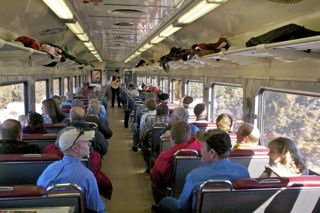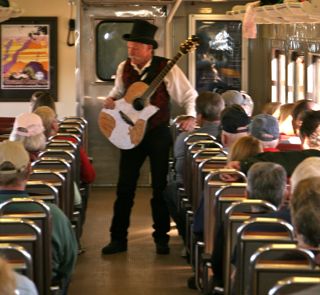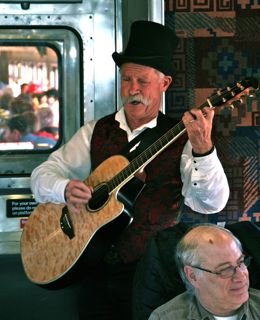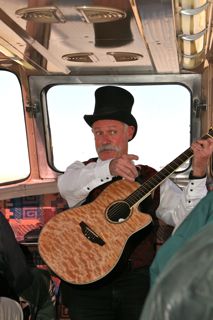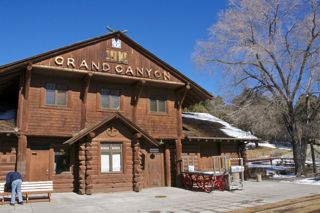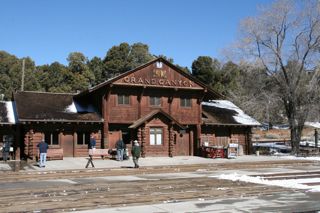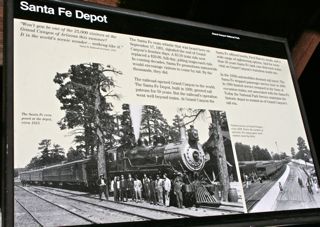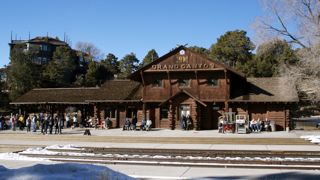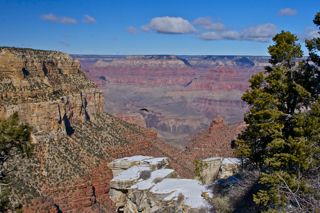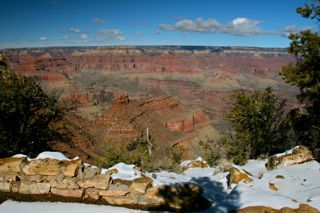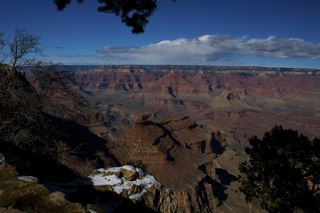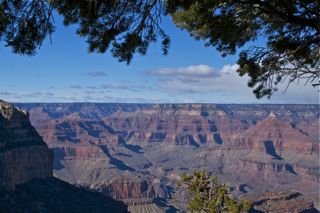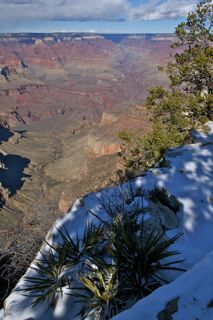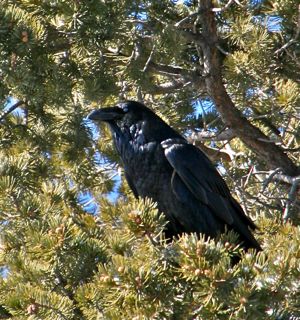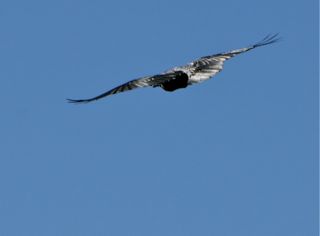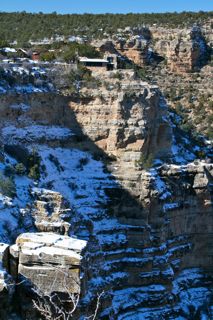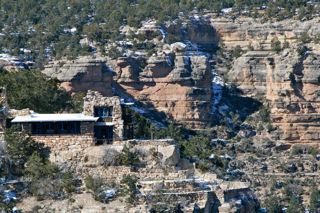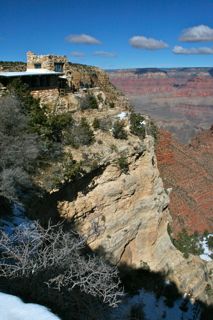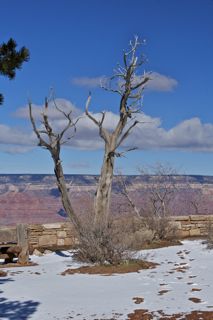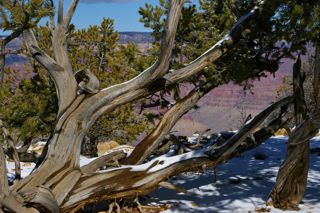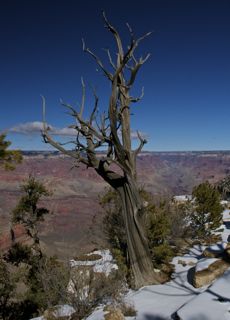Getting There
To arrive by train at the departure point of the Grand Canyon Railway, Williams, AZ, you can take the Southwest Chief from as far east as Chicago, or as far west as Los Angeles..
This trip was by car from Placentia, CA, to Williams, because by
train the trip both ways is after dark, and we wanted to have a car in
Flagstaff, to take side trips to the Grand Canyon Railway and the Verde Canyon Railroad (A report on the Verde Canyon will soon follow this report).
Since the train leaves Williams, AZ, at 9:30 a.m., and I had made
arrangements with Bruce Brossman, Director of Reservations and Sales,
for breakfast at 8 a.m. at the train station, I left Little America in
Flagstaff at 7 a.m. As I walked to my car, I saw that the "30%
chance of snow" prediction had been correct. I brushed the light,
dry snow off the windshield, and headed west on I-40 to Williams.
I drove through lightly falling snow for a while, but it stopped before
Williams. Driving less than the 75 mph speed limit, I arrived
about 45 minutes later and walked around the facility before I met
Bruce in the large dining room at the station's restaurant. Even
though it was 1.5 hrs. before departure, there were many guests having
breakfast and others milling around in the gift shop. Company
employees were keeping the snow off the sidewalks between the hotel,
parking lot, restaurant, and the station.
(Click any photo below for a double-sized image; Click BACK in your browser to return to this page.)

A light snow had fallen during the night. Grand Canyon Hotel, background, has 297 rooms.
|
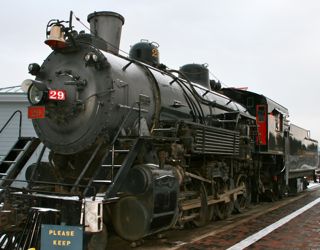
No. 29 is still outside the Restaurant, one of two working steam locomotives of the GCRR.
|


|

No. 29 was picturesque in the light snow.
|
2011 Steam Dates
Grand Canyon Railway is planning on rolling out the steamers in 2011.
The engines will once again be powered by waste vegetable oil.
On select dates, the engine will make hourly short-run departures from
Williams. The train will travel eight round trip miles. This serves as
an excellent way to ride “The Cataract Creek Rambler” - a special train
pulled by an authentic steam engine at a mere cost of $15 per adult and
$10 per child. Tickets will be available on-site (no advance
reservations).
Cataract Creek Rambler Runs:
National Train Day – May 7th & 8th
Memorial Day weekend - May 28th & 29th
Fathers Day weekend - June 18th & 19th
Independence Day weekend - July 2nd & 3rd
Trains depart on the hour from 10:00 a.m. to 4:00 p.m.
Steam Runs to the Canyon
World-famous steam locomotive No. 4960 is scheduled to pull the train
to the Grand Canyon on select dates in 2011. Plan your trip to the
canyon and enjoy being pulled by the steamer all the way to the South
Rim.
“Kick Off to Summer” - Steam to Grand Canyon – June 4, 2011
Grand Canyon Railway Anniversary Day - Steam to Grand Canyon – September 17, 2011
More info. on Steam Runs at: http://www.thetrain.com/grand-canyon-railway-steam-7275.html
|
Friendly ticket agents will give you your reserved seat tickets.
|
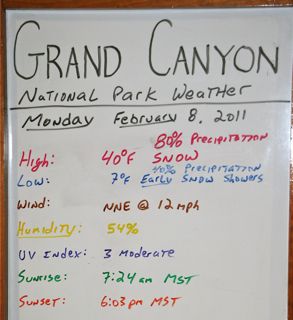
A gentle reminder to take your coat for your time at the South Rim.
|
If you are having breakfast at the restaurant, either on your own
or as part of one of the packages, notice that they have an omelet
bar. It was here that I had a delicious ham and cheese omelet
with a sweet roll from the large buffet of other breakfast items.
Grand
Depot CafÈ. The 350-seat restaurant serves breakfast, lunch and dinner
for Grand Canyon Railway passengers and patrons. Enjoy the rail
atmosphere as a model replica of the train circles the room in the
buffet-only restaurant. A full gift shop with Grand Canyon Railway
souvenirs is also in the restaurant. Breakfast buffet is from 6:30 a.m.
to 10:30 a.m. You’ll find a great selection of food including eggs,
omelets and waffles in the breakfast buffet. Lunch buffet is served
from 11 a.m. to 2 p.m. and features a broad selection. The dinner
buffet features an expansive and fresh selection of American fare.
Alcoholic beverage service is also available. Most hotel packages
include meals at the restaurant.
--from their website.

Formerly Max & Thelma's
|
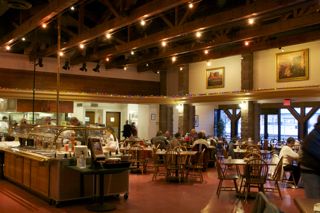
Now named Grand Depot Cafe.
|
Bruce gave me a great tour of the former Fray Marcos Hotel and
Harvey House, now being remodeled into Xantera Grand Canyon Railway offices.

Bruce Brossman, Reservations and Sales Director
Bruce gave me a
behind-the-scenes tour of the GCR offices and parts of the hotel and
Harvey House yet to be remodeled into office space.
|
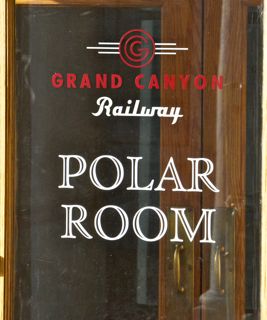
Come see Santa in 2011 aboard the Polar Express! 2011 departure dates:
• November 11*-12, 18-20, 23, 25-27, 30
• December 1-5, 7-12, 14-24, 26-30
• January 6*-7*
*6:30 p.m. train only. All other dates have both 6:30 p.m and 8:00 p.m. departure times. |

Where Mrs. Claus meets the children.
|
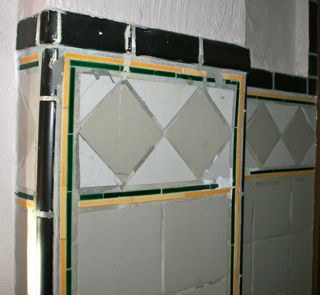
Original tile from the Harvey House dining room.
|

|
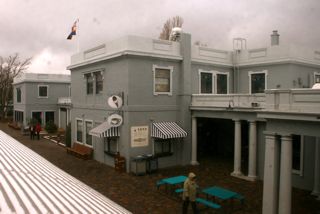
My tour was
during the cowboy show, so at 9:30 it was time to locate my Dome car
seat. This is a view of the Station and Harvey House from the
dome.
|
The Schedule
Grand Canyon Railway departs daily at 9:30 a.m. from Williams,
Arizona, about 30 miles west of Flagstaff just off Interstate 40. The
train travels almost due north to the South Rim of Grand Canyon
National Park, arriving at 11:45 a.m.. The trip measures 65 miles and
takes 2 hours and 15 minutes each way, 45 minutes faster than in 1901
when the train made its first trip. The train departs Grand Canyon
Depot at 3:30 p.m. returning to Williams Depot at 5:45 p.m.
The GCR website lists its railroad equipment at:
http://www.thetrain.com/Locomotives-&-Passenger-Cars-5685.html
(with no mention of their two operating steam locomotives).
Photos from the trip from Williams to the Grand Canyon Depot
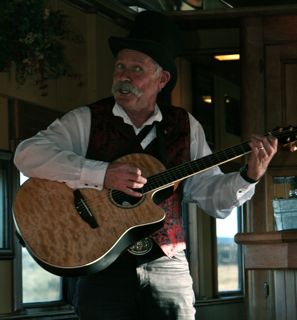
|

On the way back, he had a different set of songs he did for us in the Observation Car.
He was a very good musician and entertainer.
|
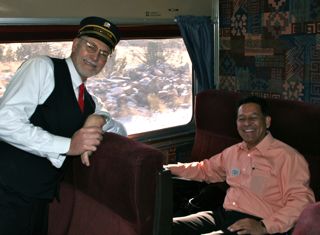
Conductor Ed Greer and On Board Supervisor Paul Sanchez and I chatted during the trip.
|
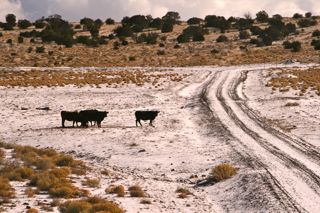
Not much wildlife on the way, just the Angus beef cattle "outstanding in their field."
|

The scenery is much the same for the 2:15 hr. ride, except when nearing the South Rim you enter some gorges and pine trees.
|
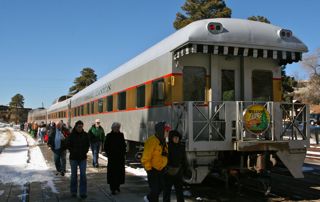
We 'wye' and back in before detraining. This puts the observation Car nearest the station.
|
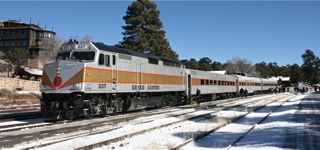
Today was as
short as the train ever gets, three cars/four classes. After
detraining is a good time to photograph the consist.
|
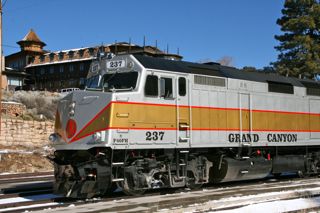
|
The Classes of Service
Coach Class, First Class, Observation Dome, and Luxury
Parlor. An excellent page of the Grand Canyon Railway's website
has complete descriptions, prices, and videos of each class at: http://www.thetrain.com/grand-canyon-train-5677.html
The Grand Canyon Railway Diesel Fleet
From the Grand Canyon Railway's website:
Today, Grand Canyon Railway is home to a remarkable collection of America’s famed diesel locomotives.
Locomotive No. 2134 is a GP-7 type built in 1953 by the
Electro-Motive Division of General Motors Corporation. Engines No.
6773, No. 6793, No. 6776 and B-Units No. 6871 and No. 6860 are all
FPA-4, built by ALCO (American Locomotive Company) in 1959.
The FPA-4 model is unique in that it is designed to be longer for
holding a steam generator in the back. The steam generator is utilized
for heating cars. Locomotive 6793 is the last of the series the FPA-4
model locomotives built. Originally belonging to Canadian National
Railway, the FPA-4 locomotives were purchased by Grand Canyon Railway
in the 1990s.
Locomotive No. 6773 began service for Grand Canyon Railway in 1991.
No 6793 began service in 1996. No. 6871 began service in 1998. B Unit
No. 6776 began service for GCR in 2000. And B Unit No. 6860 began
service for the railway in 2001.
Additionally, Grand Canyon Railway acquired three F-40PH
locomotives in February 2003. General Motors Electro motive Division
built Nos. 237 and 239 in 1977 and No. 295 in 1979. Amtrak used the
engines through the late 1990s. These engines are currently being
restored, and No. 239 entered service for the Grand Canyon Railway’s
Polar Express in 2004. No. 295 entered service in February 2009.
Grand Canyon Railway's Unique Passenger Cars
Grand Canyon Railway is home to a
unique collection of historical railway cars, each with its own story.
Grand Canyon Railway works to maintain the original look of the
railcars, showcasing rail travel’s rich and diverse history.
All of the Railway’s cars are
equipped with restrooms, staffed by a Passenger Service Attendant and
can be reserved for groups and special events.
• Budd Coach cars — Built by Budd
Manufacturing Company. Refurbished by the Grand Canyon Railway’s
locomotive shop in 2005-2006, these coach cars offer guest
air-conditioning and better serve passengers with disabilities.
•
Pullman Coach cars — Built by Pullman in 1923, Harriman-style coach
cars seat 80 to 88 passengers. The Grand Canyon Railway uses fully
restored Harriman-style coach cars exclusively for The Polar Express™.
Grand Canyon Railway established the limited schedule in 2006 to help
preserve these fascinating railcars for future generations.
• The
Bright Angel class — Grand Canyon Railway acquired the cars in 2003
from Amtrak. The complete and full restoration of the cars was
completed in 2004, and went into service as First Class coach.
•
Buckley O’Neil class — When Southern Railway passed its passenger
service to Amtrak in 1979, the Buckley O’Neil Class Cars followed, then
served on the Alaska Railroad before coming to Grand Canyon Railway.
The name of these cars honors Grand Canyon Railway’s original owner.
• The
Colorado River — This car was built in 1948 as a 16-section sleeper for
the Denver Rio Grande Western. The car changed hands multiple times
before being acquired by the Railroading Heritage of Midwest America.
Grand Canyon Railway purchased the car in June of 1999, rebuilt the car
and it into service in April 2000.
• The
Yavapai — This car was built in 1950 by the Budd Manufacturing Company
for use by the Southern Pacific. Grand Canyon Railway purchased the car
in 1998 and put it into service that year. This car was renovated in
2009.
• The
Coconino — This is a unique dome coach was built by Budd Manufacturing
Company in 1954. Grand Canyon Railway purchased it in 1996, and went
into service March 1997.
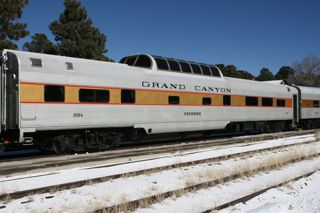
The Coconino
|
• The
Grand View — The Grand View Car ran as a Vista Dome Coach on the famed
California Zephyr, arguably one of the most famous trains of all
times. The Grand Canyon Railway acquired this classic dome coach car in
2004. The Grand View remains all original.
• The
Kokopelli — In May of 2000, Grand Canyon Railway leased car No. 1326
from the Great Northern Dome Company to replace another dome car. It
was repainted and named the Kokopelli
• The
Santa Fe — The Santa Fe was built in 1948. A 37-seat coach, it was
considered the lap of luxury, providing patrons with modern and
comfortable seats. The Grand Canyon Railway became the proud owner in
2004.
• The
Chief — Grand Canyon Railway acquired the car in 2002; this car had
many restorations and one collision prior to arriving at Grand Canyon
Railway. The Chief was put into service in October 2002.
• The
Max Biegert —This recently refurbished Luxury Parlor Car is named after
the businessman responsible for reinstating train service from Williams
to the Grand Canyon in 1989. The railcar was built in 1954 and was
originally known as the Bonaventure. The car debuted as The Max Biegert
in September 2006 and is still in use on Grand Canyon Railway today.
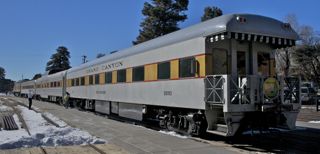
The
Max Biegert
|
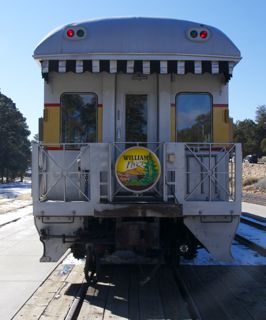
|
The Region
Grand Canyon Country is located in northern Arizona on what's called
the Colorado Plateau. Most of the plateau is set at 5,000 feet
elevation. However, the plateau includes Williams and the Grand Canyon,
both at about 7,000 feet elevation, and the San Francisco Peaks, the
highest point in Arizona at over 12,600 feet elevation. What this means
is out your window you'll pass through different landscapes, from
Ponderosa pine forests down to the open and dry high desert, and then
the train rises back into the forest as it gets close to the canyon.
There is a 1,500 foot vertical drop along the way. This can be very
challenging to engineers. In fact, for years, the Santa Fe brought out
engineers-in-training to teach them how to operate steam locomotives on
the Grand Canyon line.
View from the South Rim
Upon arriving at the South Rim, you can take a pre-arranged tour,
shop, walk along the Rim and have lunch for the 3+ hr. layover. I
did not take a bus tour this trip, so had plenty of time to
photograph, shop, and eat lunch before returning on the 3:30 train to
Williams.
The Grand Canyon Depot
The northern terminus of the line
resides in Grand Canyon National Park. Constructed in 1909-1910, Grand
Canyon Depot is part of the Grand Canyon National Park Historic
District and is a National Historic Landmark. Designed by architect
Francis W. Wilson of Santa Barbara, Calif., the log and wood-frame
structure is two stories high. Originally, the downstairs was
designated for station facilities and the upstairs was inhabited by the
station agent’s family. Today, the first floor is used for railway
passenger services. The building is one of approximately 14 log depots
known to have been constructed in the United States, and one of only
three remaining. Of the three, the Grand Canyon Depot is the only one
in which logs were used as the primary structural material and which
still serves an operating railroad. The Depot’s logs are squared on
three sides creating bearing surfaces, flat interior surfaces and a
rustic exterior appearance. Just beyond the depot is the El Tovar
Hotel, built in 1905 by the railroad. The El Tovar is the signature
hotel along the rim. The railroad built the depot five years after the
hotel and placed it conveniently close for the rail passengers.
--from the GCR website
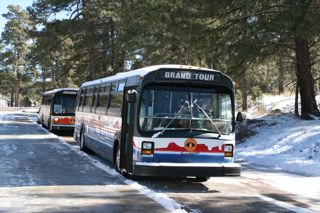
Two tours are available as you detrain.
|
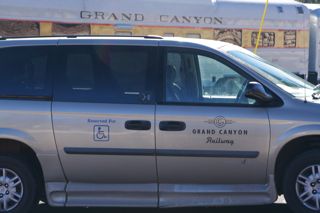
If pre-arranged, this van is available for wheelchair bound passengers.
|
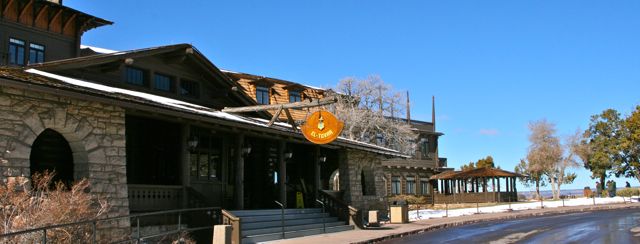
As you walk up the steps from the Depot, you see two historic buildings. On the left (above) the El Tovar Hotel. On the right (below) the Hopi House.

One of the great buildings of
Grand Canyon architect, Mary Coulter, Hopi House was designed as a
place for the Hopi Indians to create and sell their works to Grand
Canyon tourists.
|
Around the El Tovar Hotel

Front of the El Tovar.
|

From a side porch of the El Tovar.
|
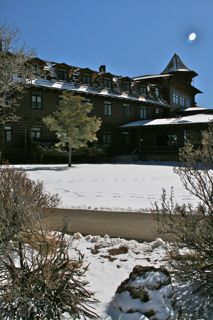
View from the Rim Trail.
|

Lunch at the El Tovar
|

Large painting in the dining room.
|
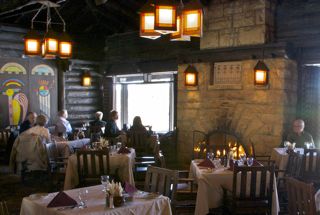
dining room with canyon view tables.
|
The Hopi House designed by Mary Coulter

|
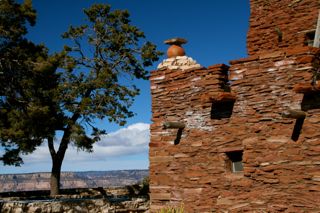
|
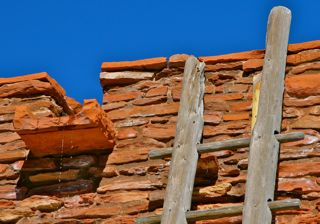
Water drain and ladder.
|
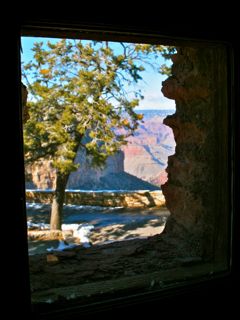
From a second floor window.
|
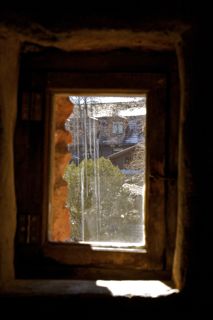
Second floor window and El Tovar Hotel.
|
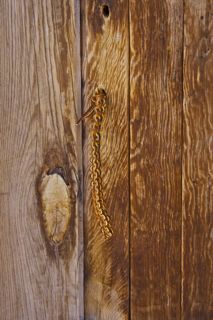
Rawhide door pull at the Hopi House.
|
Views of the Grand Canyon from the Rim Trail
I Heard a Raven's Call
The raven is one of the most
predominant birds in Grand Canyon, from their soaring aerial
acrobatics, to their clever raiding of backpacks for food. Many people
mistake them for crows, which are actually quite rare in the canyon.
Ravens are much larger than their other corvid cousins, with a heavy,
slightly curved beak and wedge-shaped tail. They mate for life, but
will find another mate if one dies. Mated pairs will rub beaks (the
first "Eskimo kiss"?), preen each other and make sweet noises that help
cement the bond between them. They build large nests made of sticks and
lined with soft materials- bark, fur, hair, or even plastic bags. The
nests are usually found on ledges or protected cliff alcoves, and
contain 3 to 7 beautiful turquoise-green eggs with brown mottling. The
female is dependent on the male to provide food for her while she sits
on the eggs, which take about three weeks to hatch. Young birds fledge
(learn to fly) in about six weeks, and will hang around the parents
loudly begging for food and generally causing mischief as they learn
about the world. Juveniles are as big as the adults, but have yellow
coloration at the edges of their mouths that turn black with maturity.
They leave mom and dad in the fall, and frequently form large flocks
where they establish social order and start the process of pair
bonding, much like groups of teenagers at the local mall! Occasionally
a pair will have one of their offspring stay with them another year and
act as a "babysitter" for the next year's youngsters.
Ravens are definitely the brains of the
bird world, and also appear to possess a great sense of humor. They
frequently will gang up on other animals such as eagles, conspiring
together to rob them of food. One will pull at the eagle's tail while
the other flies off with the prize. They have been known to guard their
nests by dropping stones on predators, including well-meaning human
researchers, who will also swear that ravens can aim their feces in an
all-out aerial attack. They love to play climbing and hanging games,
will make snowballs and roll them around, or repeatedly slide down icy
hills on their rear-ends only to walk back up and do it again. They can
imitate a variety of natural and man-made noises including frogs, dogs,
voices, and ice-cream trucks. Researchers have demonstrated their
ability to count objects up to the number six, and they will use and
even alter tools to obtain food. Many a canyon boater or backpacker has
discovered their ability to unzip zippers, and pairs have definite
territories they patrol as they wait for an unguarded food source. They
have a variety of different vocalizations, the meaning of which
actually varies form area to area. Grand Canyon ravens speak a
different dialect than Yellowstone ravens!
--from http://www.hitthetrail.com/ravens.php
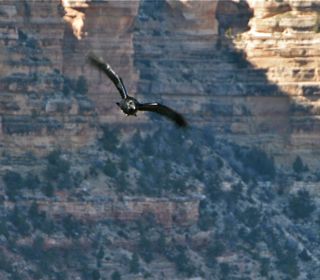
|

Bird's eye view of the Grand Canyon.
|
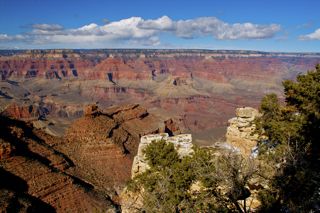
Can you still see the Raven?
|
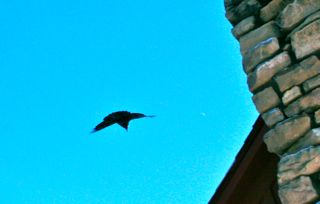
|
A Favorite Structure of Mine on the South Rim of the Grand Canyon - Lookout Studio
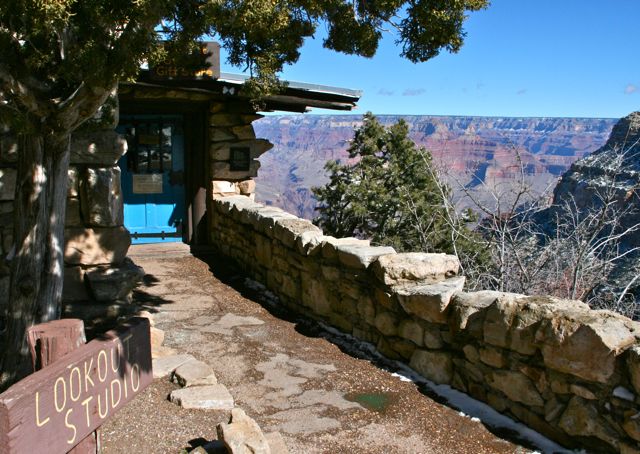
Lookout Studio is a short walk west of the El Tovar Hotel along Rim Trail. A good place to get inspired.
|

|
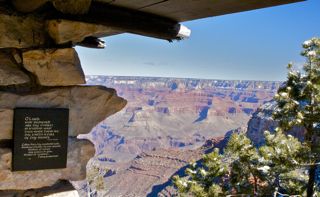
|
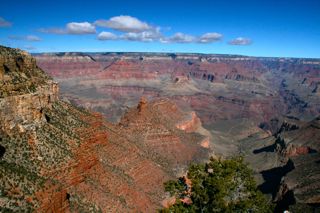
The Canyon from the 2nd floor porch.
|
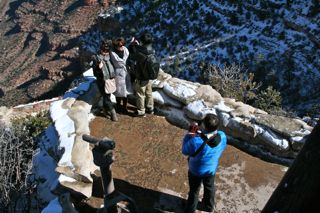
View of the upper of two outdoor patios.
|
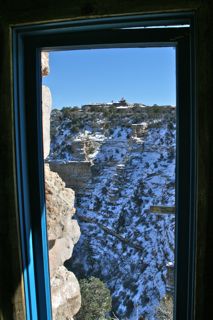
View of El Tovar from the 2nd Floor of Outlook Studio
|
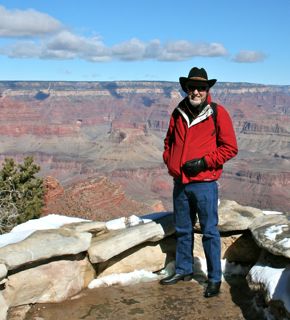
Yours Truly on the patio of Lookout Studio.
|
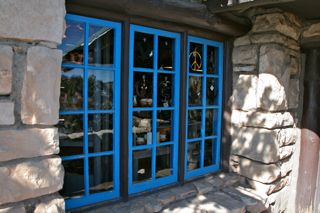
Gift shop windows at Lookout Studio
|
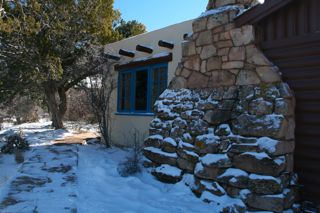
Southwest structure in winter along the Rim Trail
|
Further west on Rim Trail is Kolb Studio, also designed by Mary Colter
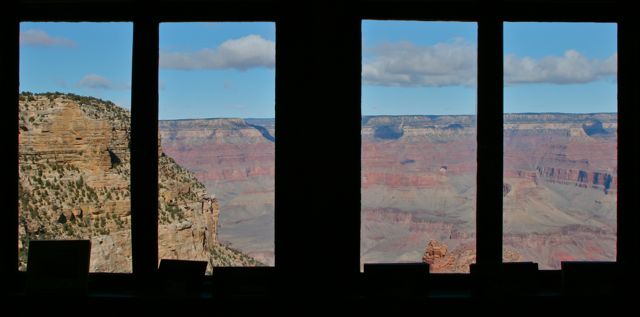
View from Kolb Studio bookstore of the Canyon
|
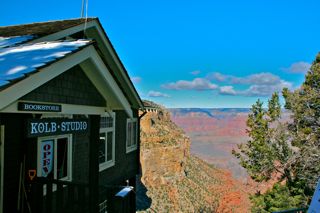
Kolb Studio, on the brink.
Right, Don't slip going down the stairs!
|
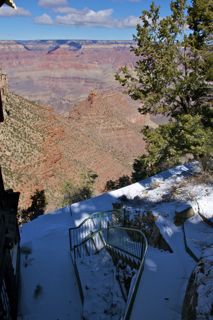
|
While walking the Rim Trail, photographing the beautiful Grand
Canyon, I also took notice of the many standing trees which no longer
were alive. I thought that these pieces of Mother Nature's
beautiful creation would have been cut down for firewood if this were
not a protected area of a National Forest. I made some
photographs of these trees to share the beauty with you.
Joyce Kilmer. 1886–1918
Trees
I THINK that I shall never see
A poem lovely as a tree.
A tree whose hungry mouth is prest
Against the sweet earth's flowing breast;
A tree that looks at God all day,
And lifts her leafy arms to pray;
A tree that may in summer wear
A nest of robins in her hair;
Upon whose bosom snow has lain;
Who intimately lives with rain.
Poems are made by fools like me,
But only God can make a tree.
I also noticed Yucca plants with snow on their spiny leaves, like peanut
butter in a stalk of celery. Always interesting to me to see
desert plants with snow on them, never thought it snowed in the desert
until I moved out west. The elevation here at the South Rim is
over 7,000 ft.
Too soon, 3:15 p.m., it was time to make my way back to the Grand
Canyon Train. With the sun lower in the sky and far south in the
winter, the train was more photogenic than earlier.
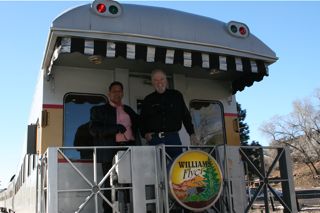
For the trip south, I was in Luxury Class, in the observation car. Here with Paul Sanchez.
|

The weather had
turned from snow in the morning to beautiful, cool, dry weather by
afternoon. I love spending time outdoors on the platform.
|
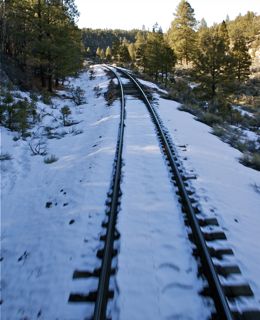
In shady areas the snow is slower to melt. I call this shot, "Tracks in the Snow."
|
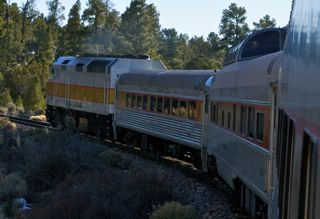
Many curves in the track soon after departure give an opportunity for a photo of the front of the train from the platform.
|
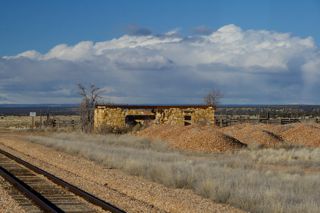
A good thing about a round trip on a train, if you miss a shot on the way up, you can get it on the way back.
|

San Francisco
Peak is due north of Flagstaff, and east of Williams. A nice view
of it is available on the 2nd half of the southbound trip.
|

Clyde Score was an excellent musician and entertainer.
|

San Francisco
Peaks (Humphreys and Agassiz ) from the Grand Canyon Railway. The land along the tracks is
National Forest, Bureau of Land Management, and a very large private
ranch.
|
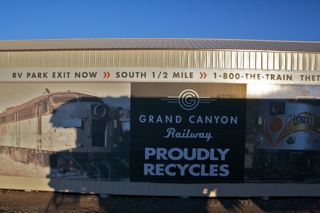
As our shadow passed the car barn, we could see a before and after shot of the locomotive.
|
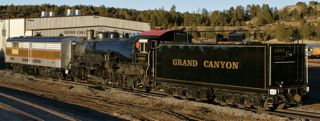
No. 4960 was easier to photograph from the observation platform than from the dome.
|
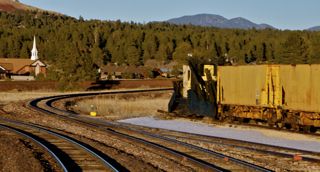
The "P Line"
goes past a snow spreader and later the Williams Station and on to
Phoenix. There are about 6 trains a day on this adjacent track.
|
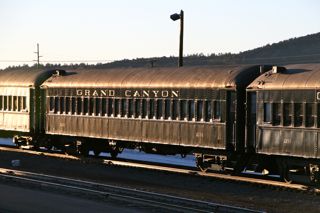
Other coaches await the call on a busier summer day.
|
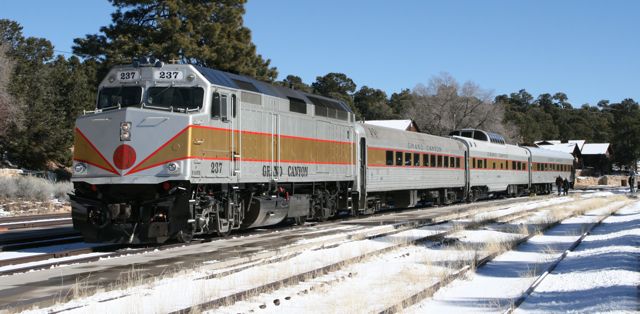
Another great ride on the Grand Canyon Railway has come to an end.
|

THE END.
|
Plan Your Trip Now!
The Train Runs every day of the year
(except Christmas Day) with many different packages. My favorite is the 3-Night package
where you stay at their Hotel in Williams, then board the train the
next morning, view the canyon all day, and stay at the South Rim the
2nd night. Then have until 3:15 p.m. at the canyon and take the
train back to Williams, staying in Williams the third night. This
way you will not have to travel before or after your ride. Food
at the restaurant a few steps from the hotel will be included in the
package. Luggage is transferred from your Williams hotel, to the
South Rim hotel, and back to the Williams hotel without your having to
touch it!
The best way to learn all the options is to go to their website:
and watch the excellent video on the first page.
You can get all the
info. you need about the various packages, and the dates of travel,
then call a great Travel Agent, who knows all about the Amtrak System
and hotels in the Southwest and she can set up the Grand Canyon Railway
trip as well as getting to and from Williams, AZ. You can even
take the Amtrak Southwest Chief, to the Grand Canyon Train.
The Southwest Chief runs daily between Chicago and Los Angeles, and
stops right in Williams. She knows all the details:
Call: Carole Walker
Bella Vista Travel
562-594-6771.
